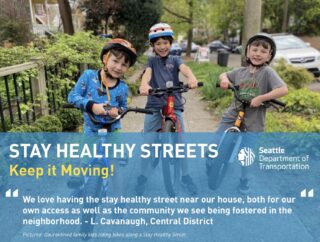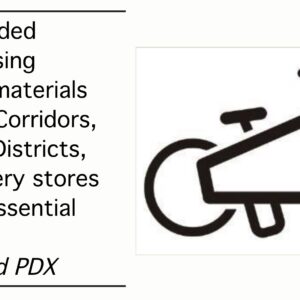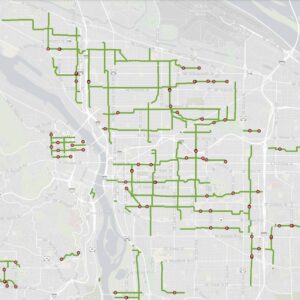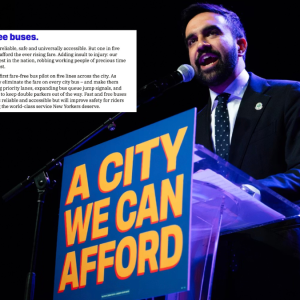
While Portland basks in the glow of finally launching a transportation-related response to the Covid-19 pandemic, Seattle has taken theirs up a notch. The city announced yesterday that 20 miles of their pilot network of traffic-calmed streets with reduced access for drivers will become permanent.
“We are in a marathon and not a sprint in our fight against COVID-19,” said Seattle Mayor Jenny Durkan in a blog post from her department of transportation. “As we assess how to make the changes that have kept us safe and healthy sustainable for the long term, we must ensure Seattle is rebuilding better than before. Stay Healthy Streets are an important tool for families in our neighborhoods to get outside, get some exercise and enjoy the nice weather. Over the long term, these streets will become treasured assets in our neighborhoods.”
“We’re announcing a nimble, creative approach towards rapidly investing in a network of places for people walking and people biking of all ages and abilities.”
— Sam Zimbabwe, Seattle DOT director
Seattle got a big head start on Portland. They launched a “Stay Healthy Streets” initiative on April 17th. On that same day in Portland we reported PBOT Commissioner Chloe Eudaly was “nervous about the consequences” of doing any street-related interventions because of concerns about equity, resource capacity, dangers posed by speeding drivers, and Portland’s lack of density.
Thankfully Eudaly has changed her tuned an announced our “Slow Streets Safe Streets” effort on April 28th. With the first 100 locations set to be fully installed sometime today, it’s unclear what kind of impact the initiative will have.
Advertisement

Meanwhile, Seattle DOT Director Sam Zimbabwe told the Seattle Times their program to keep non-essential drivers off some neighborhood streets has been, “transformative” and that they want to, “continue to build out a transportation system that enables people of all ages and abilities to bike and walk across the city.”
A blog post from Seattle DOT published yesterday (that includes photos of smiling kids and positive quotes from Healthy Streets users) said creating better bike infrastructure is also a “critical” part of their response in part due to expected drops in transit capacity. “Seattle must be able to get around without needing to rely on vehicles,” reads the post. Zimbabwe said, “That is why we’re announcing a nimble, creative approach towards rapidly investing in a network of places for people walking and people biking of all ages and abilities.”
SDOT put added emphasis on a directive from Mayor Durkan to, “Evaluate and accelerate implementation of other bicycle facilities.” “We’re taking a serious look at advancing key projects or filling gaps in the bike network to make it easier for people to ride bikes.” she said.
Portland advocates with Bike Loud PDX have called for faster implementation of existing and adopted bikeway projects — like those in the Central City in Motion plan.
Asked at a press event yesterday how long Portland’s temporary “Local Access Only” signs and barricades would be up, PBOT Communications Director said, “For the foreseeable future.”
PBOT staff have hinted that some locations are likely to be “hardened” (made permanent) to keep greenways from being overrun by drivers as physical distancing requirements soften. That move won’t come until “Phase 2.5” of their current plans which is defined as being after the Governor’s “Stay Home” order is lifted (likely to be May 15th) and before we begin to “Reinvest, Recover, Rebuild”.
— Jonathan Maus: (503) 706-8804, @jonathan_maus on Twitter and jonathan@bikeportland.org
— Get our headlines delivered to your inbox.
— Support this independent community media outlet with a one-time contribution or monthly subscription.






Thanks for reading.
BikePortland has served this community with independent community journalism since 2005. We rely on subscriptions from readers like you to survive. Your financial support is vital in keeping this valuable resource alive and well.
Please subscribe today to strengthen and expand our work.
My first thought here is how to quickly provide a feedback loop to Google / Waze / TomTom / Apple / etc to mark these safe streets as “local access only” and to thereby deprioritize / block them from being used in wayfinding apps? So much of the reasons these streets get used in the first place is Waze telling some user that they’ll trim 2.6 minutes from their trip if they take that shortcut through your neighborhood. Uber drivers, delivery drivers, etc are many times just relying on their GPS when they buzz through surface streets.
A sign that says, “this is meant to be a safe street, yo” will only do so much if the fellow’s Tesla or Google Maps is telling him he’s meant to cut straight down your street.
Creating green street networks that restrict car access, rapidly building out their public transit system, bike ridership up 18%, adjusting 800 traffic signals to give priority crossing to pedestrians. It’s almost like Seattle actually is the city Portland pretends to be!
Maybe when Chloe is given the boot, the new PBOT head can use the success in Seattle to push for actual changes here.
As the city is already violating the distance from corner requirements for parking. It seems like Portland could easily pair updating some streets to have more permanent offset planters/diverters (similar to the temporary signs show in the Seattle Times article) at the same time they are updating streets with those no parking signs/curb paint. Those offset diverters can still allow emergency vehicles through because they have clearance near the corners of the intersection. They will have to do some level of permitting/engineering to install those no parking signs, just tack on something to make drivers slower while you’re at it!
810.160 Controlling parking on highways; limitations. Except as otherwise provided in this section, each road authority has exclusive authority to regulate, control or prohibit the stopping, standing and parking of vehicles upon its own highways. The Oregon Transportation Commission shall act as road authority under this section in lieu of the Department of Transportation. The authority granted in this section is subject to all of the following:
(1) The commission has exclusive authority to regulate, control or prohibit the stopping, standing and parking on all state highways:
(a) Within the corporate limits of a city except where the highway is routed over a city street under ORS 373.010.
(b) Within the corporate limits of any city if access to or from the section of highway and real property abutting thereon was restricted, controlled or prohibited by the commission before the section of highway was included within the corporate limits of the city.
(2) Road authorities other than the commission may permit angle parking on any highway where parking is subject to their jurisdiction under this section. For cities, this subsection includes authority to permit angle parking on any city street selected and designated as the route of a state highway under ORS 373.010 and, subject to the authority of the commission under this section, any state highway within the corporate limits of the city. This subsection does not allow any road authority to permit angle parking on a state highway if the commission determines that the highway is not of sufficient width to permit angle parking without interfering with the free movement of traffic.
(3) All regulations, restrictions or prohibitions imposed by the commission under this section shall be by resolution or order entered in the commission’s official records.
(4) Regulations, restrictions or prohibitions imposed by the commission under this section shall become effective and have the force of law when signs or markings giving notice thereof have been placed. To comply with this subsection, the commission shall place and maintain appropriate signs or markings at such places as may be necessary to inform the public and to give notice of all regulations, restrictions or prohibitions the commission establishes under this section.
(5) Penalties are provided under ORS 811.575 for violation of restrictions placed on state highways under this section. [1983 c.338 §160]
My apologies if I mislead on that they were it total violation. They are technically violating one Oregon law and absolved by another. The fact that 2 state level laws and one Portland city code are all on conflict is kinda ridiculous and maybe the real decider will either be the findings of the most recent lawsuit that was brought up earlier here on bikeportland (Feb 20) or maybe a clarification will have to be picked up by an ombudsman or the state supreme court if that moves into appeal.
I think everyone can agree to the reality that a a 4000 lb car moving at 20-30 miles per hour through a narrow neighborhood street, does not have adequate stopping distance to avoid a pedestrian legally crossing at an intersection if there are cars parked all the way up to the corner. At some point we are just talking physics. As a pedestrian I don’t want to get hit and as a driver I don’t want to hit someone.
Maybe we just make every neighborhood street a 4-way stop and call it a day?
Jonathan, just curious from your POV have you seen any media backlash against the either the program in Seattle or here? Curious Portland’s appetite for making some of these changes more permanent here.
I cycled by/through one of these Stay Healthy Streets a couple days this week and my observation is (not entirely cynically) SDOT is enacting SPD’s secret and politically incorrect wish list of street closures: cutting off crucial connectors for popular (car) cruising streets and congregation of young people. With the nice weather and less work going on people have been acting like school’s out for summer.
I’m not saying the closures are a bad thing, but concerns about equity, yeah Mayor Jenny Durkan (former Federal prosecutor / shot down the Amazon payroll tax) doesn’t tend to let that impede her.